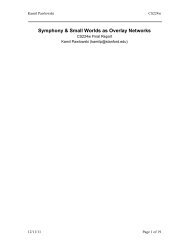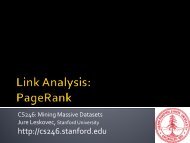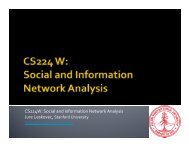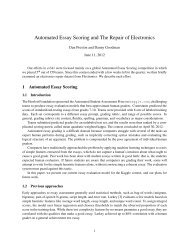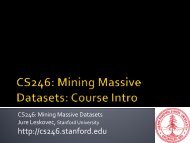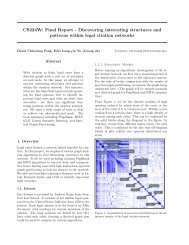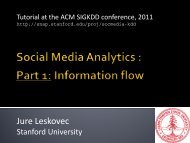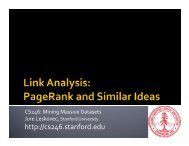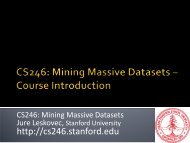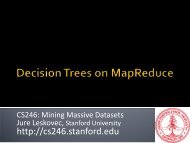Theory of Locality Sensitive Hashing - SNAP - Stanford University
Theory of Locality Sensitive Hashing - SNAP - Stanford University
Theory of Locality Sensitive Hashing - SNAP - Stanford University
Create successful ePaper yourself
Turn your PDF publications into a flip-book with our unique Google optimized e-Paper software.
CS246: Mining Massive Datasets<br />
Jure Leskovec, <strong>Stanford</strong> <strong>University</strong><br />
http://cs246.stanford.edu
Goal: Given a large number (N in the millions or<br />
billions) <strong>of</strong> text documents, find pairs that are<br />
“near duplicates”<br />
Application:<br />
Detect mirror and approximate mirror sites/pages:<br />
Don’t want to show both in a web search<br />
Problems:<br />
Many small pieces <strong>of</strong> one doc can appear out <strong>of</strong> order<br />
in another<br />
Too many docs to compare all pairs<br />
Docs are so large and so many that they cannot fit in<br />
main memory<br />
1/20/2012 Jure Leskovec, <strong>Stanford</strong> C246: Mining Massive Datasets 2
1. Shingling: Convert documents to large sets<br />
<strong>of</strong> items<br />
2. Minhashing: Convert large sets into short<br />
signatures, while preserving similarity<br />
3. <strong>Locality</strong>-sensitive hashing: Focus on pairs <strong>of</strong><br />
signatures likely to be from similar<br />
documents<br />
1/20/2012 Jure Leskovec, <strong>Stanford</strong> C246: Mining Massive Datasets 3
Docu-<br />
ment<br />
The set<br />
<strong>of</strong> strings<br />
<strong>of</strong> length k<br />
that appear<br />
in the doc-<br />
ument<br />
Signatures :<br />
short integer<br />
vectors that<br />
represent the<br />
sets, and<br />
reflect their<br />
similarity<br />
1/20/2012 Jure Leskovec, <strong>Stanford</strong> C246: Mining Massive Datasets<br />
<strong>Locality</strong>-<br />
sensitive<br />
<strong>Hashing</strong><br />
Candidate<br />
pairs :<br />
those pairs<br />
<strong>of</strong> signatures<br />
that we need<br />
to test for<br />
similarity.<br />
4
A k-shingle (or k-gram) is a sequence <strong>of</strong> k<br />
tokens that appears in the document<br />
Example: k=2; D 1= abcab<br />
Set <strong>of</strong> 2-shingles: C 1 = S(D 1) = {ab, bc, ca}<br />
Represent a doc by the set <strong>of</strong> hash values <strong>of</strong><br />
its k-shingles<br />
A natural document similarity measure is then<br />
the Jaccard similarity:<br />
Sim(D 1, D 2) = |C 1∩C 2|/|C 1∪C 2|<br />
1/20/2012 Jure Leskovec, <strong>Stanford</strong> C246: Mining Massive Datasets 5
Prob. h π(C 1) = h π(C 2) is the same as Sim(D 1, D 2):<br />
Pr[h π(C 1) = h π(C 2)] = Sim(D 1, D 2)<br />
Permutation π<br />
1<br />
3<br />
7<br />
6<br />
2<br />
5<br />
4<br />
4<br />
2<br />
1<br />
3<br />
6<br />
7<br />
5<br />
3<br />
4<br />
7<br />
6<br />
1<br />
2<br />
5<br />
1<br />
1<br />
0<br />
0<br />
0<br />
1<br />
1<br />
Input matrix<br />
0<br />
0<br />
1<br />
1<br />
1<br />
0<br />
0<br />
1<br />
0<br />
0<br />
0<br />
0<br />
1<br />
1<br />
0<br />
1<br />
1<br />
1<br />
1<br />
0<br />
0<br />
Signature matrix M<br />
1/20/2012 Jure Leskovec, <strong>Stanford</strong> C246: Mining Massive Datasets 6<br />
2<br />
1<br />
2<br />
1<br />
2<br />
1<br />
4<br />
1<br />
2<br />
1<br />
2<br />
1
ands<br />
Hash cols <strong>of</strong> signature matrix M:<br />
Similar columns likely hash to same bucket<br />
r rows<br />
Divide matrix M into b bands <strong>of</strong> r rows<br />
Candidate column pairs are those that hash<br />
to the same bucket for ≥ 1 band<br />
Buckets<br />
Matrix M<br />
Prob. <strong>of</strong> sharing<br />
a bucket<br />
Sim. threshold s<br />
1/20/2012 Jure Leskovec, <strong>Stanford</strong> C246: Mining Massive Datasets 7<br />
2<br />
1<br />
2<br />
1<br />
2<br />
1<br />
4<br />
1<br />
2<br />
1<br />
2<br />
1
The S-curve is where the “magic” happens<br />
Probability <strong>of</strong> sharing<br />
a bucket<br />
Remember:<br />
Probability <strong>of</strong><br />
equal hash-values<br />
= similarity<br />
Similarity s <strong>of</strong> two sets<br />
This is what 1 band gives you<br />
Pr[h π(C 1) = h π(C 2)] = sim(D 1, D 2)<br />
No chance<br />
if s < t<br />
Probability<br />
= 1 if s > t<br />
t<br />
This is what we want!<br />
How?<br />
By picking r and s!<br />
1/20/2012 Jure Leskovec, <strong>Stanford</strong> C246: Mining Massive Datasets 8
Remember:<br />
b bands, r rows/band<br />
Columns C 1 and C 2 have<br />
similarity s<br />
Pick any band (r rows)<br />
Prob. that all rows in band equal = s r<br />
Prob. <strong>of</strong> sharing<br />
a bucket<br />
Prob. that some row in band unequal = 1 - s r<br />
Prob. that no band identical = (1 - s r ) b<br />
Prob. that at least 1 band identical =<br />
1 - (1 - s r ) b<br />
Similarity s<br />
1/20/2012 Jure Leskovec, <strong>Stanford</strong> C246: Mining Massive Datasets<br />
9
Prob. sharing a bucket<br />
Prob. sharing a bucket<br />
1<br />
0.9<br />
0.8<br />
0.7<br />
0.6<br />
0.5<br />
0.4<br />
0.3<br />
0.2<br />
0.1<br />
r=1..10, b=1<br />
0<br />
0 0.1 0.2 0.3 0.4 0.5 0.6 0.7 0.8 0.9 1<br />
1<br />
0.9<br />
0.8<br />
0.7<br />
0.6<br />
0.5<br />
0.4<br />
0.3<br />
0.2<br />
0.1<br />
r=1, b=1..10<br />
0<br />
0 0.1 0.2 0.3 0.4 0.5 0.6 0.7 0.8 0.9 1<br />
Similarity<br />
0<br />
0 0.1 0.2 0.3 0.4 0.5 0.6 0.7 0.8 0.9 1<br />
1/19/2011 Jure Leskovec, <strong>Stanford</strong> C246: Mining Massive Datasets 10<br />
1<br />
0.9<br />
0.8<br />
0.7<br />
0.6<br />
0.5<br />
0.4<br />
0.3<br />
0.2<br />
0.1<br />
1<br />
0.9<br />
0.8<br />
0.7<br />
0.6<br />
0.5<br />
0.4<br />
0.3<br />
0.2<br />
0.1<br />
r=5, b=1..50<br />
r=10, b=1..50<br />
0<br />
0 0.1 0.2 0.3 0.4 0.5 0.6 0.7 0.8 0.9 1<br />
Similarity<br />
1 - (1 - s r ) b
Docu-<br />
ment<br />
The set<br />
<strong>of</strong> strings<br />
<strong>of</strong> length k<br />
that appear<br />
in the doc-<br />
ument<br />
Signatures :<br />
short integer<br />
vectors that<br />
represent the<br />
sets, and<br />
reflect their<br />
similarity<br />
<strong>Locality</strong>-<br />
sensitive<br />
<strong>Hashing</strong><br />
Candidate<br />
pairs:<br />
those pairs<br />
<strong>of</strong> signatures<br />
that we need<br />
to test for<br />
similarity.
We have used LSH to find similar documents<br />
In reality, columns in large sparse matrices with<br />
high Jaccard similarity<br />
e.g., customer/item purchase histories<br />
Can we use LSH for other distance measures?<br />
e.g., Euclidean distances, Cosine distance<br />
Let’s generalize what we’ve learned!<br />
1/19/2011 Jure Leskovec, <strong>Stanford</strong> C246: Mining Massive Datasets<br />
12
For min-hash signatures, we got a min-hash<br />
function for each permutation <strong>of</strong> rows<br />
An example <strong>of</strong> a family <strong>of</strong> hash functions:<br />
A “hash function” is any function that takes two<br />
elements and says whether or not they are “equal”<br />
Shorthand: h(x) = h(y) means “h says x and y are equal”<br />
A family <strong>of</strong> hash functions is any set <strong>of</strong> hash functions<br />
A set <strong>of</strong> related hash functions generated by some mechanism<br />
We should be able to efficiently pick a hash function at<br />
random from such a family<br />
1/19/2011 Jure Leskovec, <strong>Stanford</strong> C246: Mining Massive Datasets<br />
13
Suppose we have a space S <strong>of</strong> points with<br />
a distance measure d<br />
A family H <strong>of</strong> hash functions is said to be<br />
(d 1,d 2,p 1,p 2)-sensitive if for any x and y in S :<br />
1. If d(x,y) < d 1, then the probability over all h ∈ H,<br />
that h(x) = h(y) is at least p 1<br />
2. If d(x,y) > d 2, then the probability over all h ∈ H,<br />
that h(x) = h(y) is at most p 2<br />
1/19/2011 Jure Leskovec, <strong>Stanford</strong> C246: Mining Massive Datasets<br />
14
High<br />
probability;<br />
at least p 1<br />
Pr[h(x) = h(y)]<br />
p 1<br />
p 2<br />
d 1<br />
d(x,y)<br />
d 2<br />
Low<br />
probability;<br />
at most p 2<br />
1/19/2011 Jure Leskovec, <strong>Stanford</strong> C246: Mining Massive Datasets<br />
15
Let:<br />
S = sets,<br />
d = Jaccard distance,<br />
H is family <strong>of</strong> minhash functions for all<br />
permutations <strong>of</strong> rows<br />
Then for any hash function h ∈ H:<br />
Pr[h(x)=h(y)] = 1-d(x,y)<br />
Simply restates theorem about min-hashing in<br />
terms <strong>of</strong> distances rather than similarities<br />
1/19/2011 Jure Leskovec, <strong>Stanford</strong> C246: Mining Massive Datasets<br />
16
Claim: H is a (1/3, 2/3, 2/3, 1/3)-sensitive family<br />
for S and d.<br />
If distance < 1/3<br />
(so similarity > 2/3)<br />
Then probability<br />
that min-hash values<br />
agree is > 2/3<br />
For Jaccard similarity, minhashing gives us a<br />
(d 1,d 2,(1-d 1),(1-d 2))-sensitive family for any d 1
Can we reproduce the “S-curve”<br />
effect we saw before for any LS<br />
family?<br />
Prob. <strong>of</strong> sharing<br />
a bucket<br />
The “bands” technique we learned<br />
for signature matrices carries over<br />
to this more general setting<br />
Two constructions:<br />
AND construction like “rows in a band”<br />
OR construction like “many bands”<br />
Similarity s<br />
1/19/2011 Jure Leskovec, <strong>Stanford</strong> C246: Mining Massive Datasets<br />
18
Given family H, construct family H’ consisting<br />
<strong>of</strong> r functions from H<br />
For h = [h 1,…,h r] in H’,<br />
h(x)=h(y) if and only if h i(x)=h i(y) for all i<br />
Theorem: If H is (d 1,d 2,p 1,p 2)-sensitive,<br />
then H’ is (d 1,d 2,(p 1) r ,(p 2) r )-sensitive<br />
Pro<strong>of</strong>: Use the fact that h i ’s are independent<br />
1/19/2011 Jure Leskovec, <strong>Stanford</strong> C246: Mining Massive Datasets<br />
19
Given family H, construct family H’ consisting <strong>of</strong><br />
b functions from H<br />
For h = [h 1,…,h b] in H’,<br />
h(x)=h(y) if and only if h i(x)=h i(y) for at least 1 i<br />
Theorem: If H is (d 1,d 2,p 1,p 2)-sensitive,<br />
then H’ is (d 1,d 2,1-(1-p 1) b ,1-(1-p 2) b )-sensitive<br />
Pro<strong>of</strong>: Use the fact that h i ’s are independent<br />
1/19/2011 Jure Leskovec, <strong>Stanford</strong> C246: Mining Massive Datasets<br />
20
AND makes all probs. shrink, but by choosing r<br />
correctly, we can make the lower prob. approach<br />
0 while the higher does not<br />
OR makes all probs. grow, but by choosing b<br />
correctly, we can make the upper prob. approach<br />
1 while the lower does not<br />
Prob. sharing a bucket<br />
1<br />
0.9<br />
0.8<br />
0.7<br />
0.6<br />
0.5<br />
0.4<br />
0.3<br />
0.2<br />
0.1<br />
AND<br />
r=1..10, b=1<br />
0<br />
0 0.1 0.2 0.3 0.4 0.5 0.6 0.7 0.8 0.9 1<br />
Prob. sharing a bucket<br />
0<br />
0 0.1 0.2 0.3 0.4 0.5 0.6 0.7 0.8 0.9 1<br />
1/19/2011 Jure Leskovec, <strong>Stanford</strong> C246: Mining Massive Datasets 21<br />
1<br />
0.9<br />
0.8<br />
0.7<br />
0.6<br />
0.5<br />
0.4<br />
0.3<br />
0.2<br />
0.1<br />
OR<br />
r=1, b=1..10<br />
Similarity <strong>of</strong> a pair <strong>of</strong> items Similarity <strong>of</strong> a pair <strong>of</strong> items<br />
1-(1-s r ) b
-way AND followed by b-way OR construction<br />
Exactly what we did with min-hashing<br />
If bands match in all r values hash to same bucket<br />
Cols that are hashed into at least 1 common bucket <br />
Candidate<br />
Take points x and y s.t. Pr[h(x) = h(y)] = p<br />
H will make (x,y) a candidate pair with prob. p<br />
Construction makes (x,y) a candidate pair with<br />
probability 1-(1-p r ) b<br />
The S-Curve!<br />
Example: Take H and construct H’ by the AND<br />
construction with r = 4. Then, from H’, construct<br />
H’’ by the OR construction with b = 4<br />
1/19/2011 Jure Leskovec, <strong>Stanford</strong> C246: Mining Massive Datasets<br />
22
Picking r and b to get the best<br />
50 hash-functions (r=5, b=10)<br />
Prob. sharing a bucket<br />
1<br />
0.9<br />
0.8<br />
0.7<br />
0.6<br />
0.5<br />
0.4<br />
0.3<br />
0.2<br />
0.1<br />
0<br />
0 0.1 0.2 0.3 0.4 0.5 0.6 0.7 0.8 0.9 1<br />
Similarity<br />
Blue area: False Negative rate<br />
Green area: False Positive rate<br />
1/19/2011 Jure Leskovec, <strong>Stanford</strong> C246: Mining Massive Datasets 23
Picking r and b to get the best<br />
50 hash-functions (b*r=50)<br />
1<br />
0.9<br />
0.8<br />
0.7<br />
0.6<br />
0.5<br />
0.4<br />
0.3<br />
0.2<br />
0.1<br />
0<br />
0 0.1 0.2 0.3 0.4 0.5 0.6 0.7 0.8 0.9 1<br />
r=2, b=25<br />
r=5, b=10<br />
r=10, b=5<br />
1/19/2011 Jure Leskovec, <strong>Stanford</strong> C246: Mining Massive Datasets 24
p 1-(1-p 4 ) 4<br />
.2 .0064<br />
.3 .0320<br />
.4 .0985<br />
.5 .2275<br />
.6 .4260<br />
.7 .6666<br />
.8 .8785<br />
.9 .9860<br />
Example: Transforms a<br />
(.2,.8,.8,.2)-sensitive<br />
family into a<br />
(.2,.8,.8785,.0064)-<br />
sensitive family.<br />
1/19/2011 Jure Leskovec, <strong>Stanford</strong> C246: Mining Massive Datasets<br />
25
Apply a b-way OR construction followed by an<br />
r-way AND construction<br />
Transforms probability p into (1-(1-p) b ) r .<br />
The same S-curve, mirrored horizontally and<br />
vertically<br />
Example: Take H and construct H’ by the OR<br />
construction with b = 4. Then, from H’,<br />
construct H’’ by the AND construction<br />
with r = 4.<br />
1/19/2011 Jure Leskovec, <strong>Stanford</strong> C246: Mining Massive Datasets<br />
26
p (1-(1-p) 4 ) 4<br />
.1 .0140<br />
.2 .1215<br />
.3 .3334<br />
.4 .5740<br />
.5 .7725<br />
.6 .9015<br />
.7 .9680<br />
.8 .9936<br />
Example: Transforms a<br />
(.2,.8,.8,.2)-sensitive<br />
family into a<br />
(.2,.8,.9936,.1215)-<br />
sensitive family.<br />
1/19/2011 Jure Leskovec, <strong>Stanford</strong> C246: Mining Massive Datasets 27
Example: Apply the (4,4) OR-AND<br />
construction followed by the (4,4) AND-OR<br />
construction<br />
Transforms a (0.2,0.8,0.8,.02)-sensitive family<br />
into a (0.2,0.8,0.9999996,0.0008715)sensitive<br />
family<br />
Note this family uses 256 (=4*4*4*4) <strong>of</strong> the<br />
original hash functions<br />
1/19/2011 Jure Leskovec, <strong>Stanford</strong> C246: Mining Massive Datasets<br />
28
Pick any two distances x < y<br />
Start with a (x, y, (1-x), (1-y))-sensitive family<br />
Apply constructions to produce (x, y, p, q)sensitive<br />
family, where p is almost 1 and q is<br />
almost 0<br />
The closer to 0 and 1 we get, the more hash<br />
functions must be used<br />
1/19/2011 Jure Leskovec, <strong>Stanford</strong> C246: Mining Massive Datasets<br />
29
LSH methods for other distance metrics:<br />
Points<br />
Cosine: Random Hyperplanes<br />
Euclidean: Project on lines<br />
Signatures: short<br />
integer signatures that<br />
reflect their similarity<br />
Design a (x,y,p,q)-sensitive<br />
family <strong>of</strong> hash functions<br />
(for that particular<br />
distance metric)<br />
<strong>Locality</strong>-<br />
sensitive<br />
<strong>Hashing</strong><br />
Candidate pairs :<br />
those pairs <strong>of</strong><br />
signatures that<br />
we need to test<br />
for similarity.<br />
Amplify the family<br />
using AND and OR<br />
constructions<br />
1/19/2011 Jure Leskovec, <strong>Stanford</strong> C246: Mining Massive Datasets 30
For cosine distance,<br />
d(A, B) = θ = arccos(A⋅B/ǁAǁǁBǁ)<br />
there is a technique called<br />
Random Hyperplanes<br />
Technique similar to minhashing<br />
Random Hyperplanes is a (d 1,d 2,(1-d 1/180),(1d<br />
2/180))-sensitive family for any d 1 and d 2<br />
Reminder: (d 1,d 2,p 1,p 2)-sensitive<br />
1. If d(x,y) < d 1, then prob. that h(x) = h(y) is at least p 1<br />
2. If d(x,y) > d 2, then prob. that h(x) = h(y) is at most p 2<br />
1/19/2011 Jure Leskovec, <strong>Stanford</strong> C246: Mining Massive Datasets<br />
31
Pick a random vector v, which determines a<br />
hash function h v with two buckets<br />
h v(x) = +1 if v⋅x > 0; = -1 if v⋅x < 0<br />
LS-family H = set <strong>of</strong> all functions derived<br />
from any vector<br />
Claim: For points x and y,<br />
Pr[h(x) = h(y)] = 1 – d(x,y)/180<br />
1/19/2011 Jure Leskovec, <strong>Stanford</strong> C246: Mining Massive Datasets<br />
32
Look in the<br />
plane <strong>of</strong> x<br />
and y.<br />
Hyperplane<br />
normal to v<br />
h(x) = h(y)<br />
v<br />
θ<br />
1/19/2011 Jure Leskovec, <strong>Stanford</strong> C246: Mining Massive Datasets 33<br />
x<br />
y<br />
Prob[Red case]<br />
= θ/180<br />
v<br />
Hyperplane<br />
normal to v<br />
h(x) ≠ h(y)
Pick some number <strong>of</strong> random vectors, and<br />
hash your data for each vector<br />
The result is a signature (sketch) <strong>of</strong> +1’s<br />
and –1’s for each data point<br />
Can be used for LSH like the minhash<br />
signatures for Jaccard distance<br />
Amplified using AND and OR constructions<br />
1/19/2011 Jure Leskovec, <strong>Stanford</strong> C246: Mining Massive Datasets<br />
34
Expensive to pick a random vector in M<br />
dimensions for large M<br />
M random numbers<br />
A more efficient approach<br />
It suffices to consider only vectors v<br />
consisting <strong>of</strong> +1 and –1 components<br />
Why is this more efficient?<br />
1/19/2011 Jure Leskovec, <strong>Stanford</strong> C246: Mining Massive Datasets<br />
35
Simple idea: Hash functions correspond to lines<br />
Partition the line into buckets <strong>of</strong> size a<br />
Hash each point to the bucket containing its<br />
projection onto the line<br />
Nearby points are always close; distant points<br />
are rarely in same bucket<br />
1/19/2011 Jure Leskovec, <strong>Stanford</strong> C246: Mining Massive Datasets<br />
36
Bucket<br />
width a<br />
Points at<br />
distance d<br />
If d
If d >> a, θ must<br />
be close to 90 o<br />
for there to be<br />
any chance points<br />
go to the same<br />
bucket.<br />
Bucket<br />
width a<br />
Points at<br />
distance d<br />
θ<br />
d cos θ<br />
Randomly<br />
chosen<br />
line<br />
1/19/2011 Jure Leskovec, <strong>Stanford</strong> C246: Mining Massive Datasets<br />
38
If points are distance d < a/2, prob. they are in same<br />
bucket ≥ 1- d/a = ½<br />
If points are distance > 2a apart, then they can be in<br />
the same bucket only if d cos θ ≤ a<br />
cos θ ≤ ½<br />
60 < θ < 90<br />
i.e., at most 1/3 probability.<br />
Yields a (a/2, 2a, 1/2, 1/3)-sensitive family <strong>of</strong> hash<br />
functions for any a<br />
Amplify using AND-OR cascades<br />
1/19/2011 Jure Leskovec, <strong>Stanford</strong> C246: Mining Massive Datasets<br />
39
For previous distance measures, we could<br />
start with an (x, y, p, q)-sensitive family for<br />
any x < y, and drive p and q to 1 and 0 by<br />
AND/OR constructions<br />
Here, we seem to need y > 4x<br />
1/19/2011 Jure Leskovec, <strong>Stanford</strong> C246: Mining Massive Datasets<br />
40
But as long as x < y, the probability <strong>of</strong> points<br />
at distance x falling in the same bucket is<br />
greater than the probability <strong>of</strong> points at<br />
distance y doing so<br />
Thus, the hash family formed by projecting<br />
onto lines is an (x, y, p, q)-sensitive family for<br />
some p > q<br />
Then, amplify by AND/OR constructions<br />
1/19/2011 Jure Leskovec, <strong>Stanford</strong> C246: Mining Massive Datasets<br />
41



